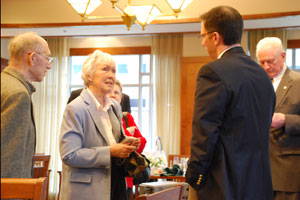
Professor John Hall speaks with attendees after his presentation.
Native Americans have served in the military since World War II. The percentage of Native Americans in the military is, in fact, disproportionately high relative to the population of the United States. However, the image of Indians as warriors has not advanced much beyond the largely European idea of the “noble savage” with a Mohawk haircut and a painted face. At the March 22 Bascom Hill Society luncheon, John Hall, the first Ambrose-Hessletine professor of military history, illustrated this image with a poster that was in demand after World War II and remains so today. It depicts a 19th century Native American dressed as a WWII paratrooper. In his presentation, “Mohawks in Normandy: Native American Imagery and Service in the Second World War” Professor Hall noted that typically it was non-Indian soldiers who shaved their heads and donned warpaint.
Perhaps the best-known Native American soldiers in popular culture were the “Code Talkers.” These Navajos communicated with one another and their battlefield units in their native language which the Japanese were never able to translate. However, of the 25,000 (out of a total service-eligible population of about 42,000), Native Americans who served in WWII, only a few hundred were codetalkers. What do we know today of the others? Why did they volunteer in such numbers? And, perhaps most intriguing, who did they fight for?
Downloads
- MP3 Recording (0:51, 29.5 MB)
Professor John Hall, also may correctly be called Major Hall. He served more than 15 years as an active-duty United States Army officer. John grew up near Whitewater and is the son of a Vietnam veteran. He is a graduate of West Point and returned there to teach history from 2003 to 2006, earning an Excellence in Teaching Award. He received his doctorate from the University of North Carolina in 2007. John’s primary area of research is the 19th century. His first book, “Uncommon Defense: Indian Allies in the Black Hawk War,” was published in 2009 and is a groundbreaking interpretation of the development of American military relations with Native Americans. In his work, he seeks to identify historical themes that can enlighten and inform current military policy. “It is impossible,” he has said, “to anticipate the future without understanding the past.”
Correction: An earlier version of this story indicated, “Native Americans have served in the military since World War I.”
